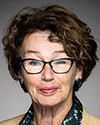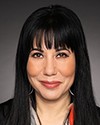I'm not going to speak to a specific section, but in general, I think we need to ask how big the housing need is, and in a most pronounced way, what we are spending. It's hard to get it from the Parliamentary Budget Office because even though we asked for the breakdown of provincial numbers, we didn't get it. What are we spending in the provinces that might be better spent in indigenous communities themselves, where we know with absolute certainty that it's landing in indigenous households. The goal here is not just to create the program, but also to consolidate existing programs so that we know exactly how we're dealing with indigenous housing as a federal program. It's clear we can't rely on the provinces to partner with us with any certainty.
The second thing in terms of the projection of housing needs now, based on the demographics of the indigenous communities outside the reserve system, which means modern treaties as well as the territories, is that the other information we're likely to need is the demographic growth projections to scale the report, so that we don't solve yesterday's problem tomorrow with today's numbers. Instead, we do it with tomorrow's numbers as part of the solution for tomorrow.
The final piece of it is to break down, based somewhat on what the Parliament Budget Office tried to do, what we need to build, what we need to repair and what we need to subsidize in order to make it viable housing. Good housing systems typically are 50% subsidy, 25% construction and 25% maintenance. That's typically where you try to land your dollars.
I have a feeling that within the backlog of repairs here, we're going to need some sort of assessment of the outstanding state of good repair in existing housing.
The final piece is to make sure that we understand how this intersects with the missing and murdered indigenous women's report and that we also understand that women's housing, housing for youth, and in particular, housing for youth coming out of care are probably the most vulnerable subpopulations of indigenous housing need, even though that covers everything but men in some ways. The reality is that we need to know the demographic split because as we saw in the PBO report, larger families and larger households are typical of indigenous composition. At the same time, we also note that the lack of safe space for individuals puts them in incredibly vulnerable situations. We need a demographic breakdown of what's unique about the housing model so we can scale it appropriately.
The final piece, which I think we need more information on, is that we don't know where the 53% of indigenous people in subsidized housing are. We know that they're getting it—that's what the report tells us—but we don't know whether they're in provincial systems, private systems or indigenous systems or whether their subsidy is coming from a different form of pension, like disability or what have you. If there was any way of helping us to understand exactly what the subsidy needs to be, because the other thing that stood out to me in the report—that I didn't get a chance to ask them about— was that they calculate core housing at 25% for indigenous people whereas it's a 33% calculation for most other Canadians. Why is there an 8% differential for indigenous peoples and do we need to accommodate that in projecting program costs?
Those are some very specific requests that are unanswered by the PBO and some of the testimony we heard.
I hope that isn't too specific and long on the list, but there it is.






